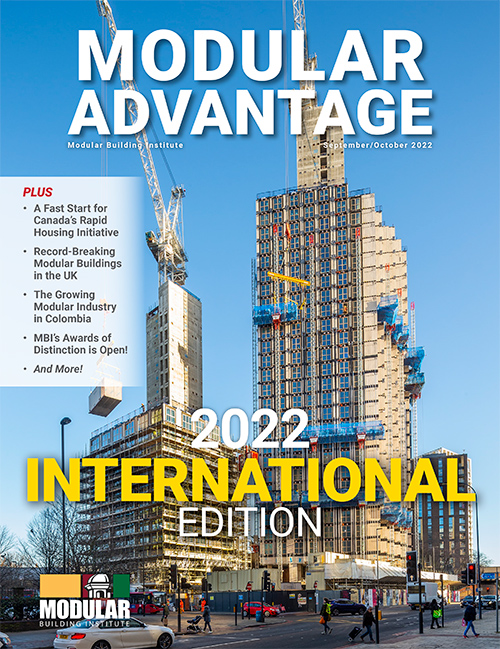In this issue of its bi-monthly Modular Advantage magazine, the Modular Building Institute (MBI) explores modular construction projects from around the world including the rapid rise of affordable modular housing in Canada
In Canada, the Canadian Mortgage Housing Corporation (CMHC) has been funnelling billions of through its Rapid Housing Initiative (RHI). Launched in late 2020 in the wake of COVID-19, the RHI was designed to address the urgent housing needs of vulnerable Canadians. The initial round of the RHI’s funding—all of which went toward modular buildings—was CN $1 billion, and in the immediate wake of COVID-19, it went quickly.
“The federal funding available through RHI set out to cover the construction of new rental housing units that would be available for occupancy within 12 months,” says Mark Becker, Chief Operating Officer at Dexterra Group and interim President, NRB Modular Solutions. “This is a very tight timeline to deliver on and it made modular construction an attractive choice to provide the fastest path to occupancy.”
As it has from the beginning, MBI is working closely with the CHMC to funnel as much of these committed funds as possible to the modular-focused RHI, which itself is currently working on the application guidelines for its expected third round of funding. For more information, and to see several case studies of completed RHI projects, click here.
Stacking up: How vision modular is helping take modular construction to new heights
As the manufacturer of some of the United Kingdom’s—and indeed the world’s—tallest modular buildings, Vision Modular Systems has learned a thing or two about building upwards. Launched little over a decade ago as the modular building division of developer/contractor Tide Construction, Vision has steadily moved from one celebrated project to another. It’s 101 George Street and College Road projects are currently among of the tallest modular buildings in the world, and it just announced plans for a 48-story student housing building in the Canary Wharf district of London.
In this interview, John Fleming, president and inventor at Vision Modular and Tide Construction, discusses the work that’s gone into creating these buildings. “There is a continuing investment program in our technologies, ongoing rigorous research and development, and testing regimes. When the business started, we were building low-rise projects. We’re now delivering schemes of 50 stories, clearly demonstrating the evolution and advancement of the system. We’re designing and delivering flexible schemes that reflect the demands of our clients across a range of asset classes,” says Fleming.
Learn more about what’s next for Vision Modular here.
Seeing the potential for modular construction in colombia
Modular construction is essentially non-existent in Colombia today. Only a handful of modular homes have been commissioned and built since 2015, mainly for extremely rugged and limited-access locations. In fact, only one modular construction company has ever existed in Colombia. Founded in 2017, it employed 4 workers, and essentially shut down (revenue drop of 100%) in 2020 due to the pandemic.
So why does the country’s largest developer see a future in modular?
“It was immediately obvious that modular construction could be the answer to several current construction issues we’re dealing with in Colombia today,” said Andrés Felipe Becerra Ceballos, Constructora Bolivar’s Head of R&D. “By implementing modular construction techniques, we can provide a durable quality product, at a lower cost, in a shorter time frame, while minimizing waste, and promoting sustainability.”
And Much More!
The latest “International Edition” of MBI’s Modular Advantage magazine contains these stories and many more. Don’t miss an issue! Subscribe at modular.org today.



